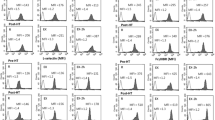Abstract
Purpose
Oxidative stress-induced lymphocyte apoptosis is linked to hypoxemic individuals suffering from cardiopulmonary disorders or exposed to hypoxic environments. What kind of the exercise strategy under hypoxic condition improves exercise performance and simultaneously minimizes lymphocyte dysfunction caused by oxidative stress has not yet been established. This study elucidates how various exercises regimens with/without hypoxia affect lymphocyte apoptosis induced by oxidative stress.
Methods
A total of 60 sedentary males were randomly divided into five groups. Each group (n = 12) received one of the five interventions: hypoxic-absolute exercise (HAT, 50%Wmax under 15%O2), hypoxic-relative exercise (HRT, 50% heart rate reserve under 15%O2), normoxic exercise (NT, 50%Wmax under 21%O2), hypoxic control (HC, resting under 15%O2), or normoxic control (NC, resting under 21%O2) for 30 min/day, 5 days/week for 4 weeks.
Results
Before the intervention, the graded exercise test (GXT, progressive exercise up to VO2max) decreased the surface thiol level on lymphocytes and subsequently augmented the extents of H2O2-induced mitochondria transmembrane potential (MTP) diminishing, caspase 3/8/9 activations, and phosphotidyl serine (PS) exposure in lymphocytes. However, 4 weeks of NT, HRT, or HAT reduced the extents of surface thiol decreasing on lymphocytes and H2O2-induced MTP diminishing, caspase 3/8/9 activations, and PS exposure in lymphocytes following GXT. Moreover, the HAT group exhibited greater improvements in pulmonary ventilation and VO2max than either NT or HRT group did.
Conclusions
Exercise training with/without hypoxic exposure effectively alleviates lymphocyte apoptosis induced by oxidative stress following strenuous exercise. However, the HAT is superior to the NT or HRT for enhancing aerobic capacity.









Similar content being viewed by others
References
American college of sports medicine (2014) Clinical exercise testing. ACSM’s guidelines for exercise testing and prescription, 9th edn. Lippincott Williams & Wilkins, Philadelphia, pp 114–141
B´eguin PC, Joyeux-Faure M, Godin-Ribuot D, L´evy P, Ribuot C (2005) Acute intermittent hypoxia improves rat myocardium tolerance to ischemia. J Appl Physiol 99:1064–1069
Bedner E, Li X, Gorczyca W, Melamed MR, Darzynkiewicz Z (1999) Analysis of apoptosis by laser scanning cytometry. Cytometry 35:181–195
Caldwell CC, Kojima H, Lukashev D, Armstrong J, Farber M, Apasov SG, Sitkovsky MV (2001) Differential effects of physiologically relevant hypoxic conditions on T lymphocyte development and effector functions. J Immunol 167:6140–6149
Coppola S, Ghibelli L (2000) GSH extrusion and the mitochondrial pathway of apoptotic signaling. Biochem Soc Trans 28:56–61
Green DR (1998) Apoptotic pathways: the roads to ruin. Cell 94:695–698
Gupta S (2005) Molecular mechanisms of apoptosis in the cells of the immune system in human aging. Immunol Rev 205:114–129
Hampton MB, Fadeel B, Orrenius S (1998) Redox regulation of the caspases during apoptosis. Ann NY Acad Sci 854:328–333
Higuchi Y (2003) Chromosomal DNA fragmentation in apoptosis and necrosis induced by oxidative stress. Biochem Pharm 66:1527–1535
Horan AD, Chan CY, Pletcher CH, Menon C, Evans SM, Moore JS, Koch CJ (1997) Analysis of tumor thiol concentrations: comparison of flow cytometric with chemical and biochemical techniques. Cytometry 29:76–82
Kesarwani P, Murali AK, Al-Khami AA, Mehrotra S (2013) Redox regulation of T-cell function: from molecular mechanisms to significance in human health and disease. Antioxid Redox Signal 18:1497–1534
Krüger K, Mooren FC (2014) Exercise-induced leukocyte apoptosis. Exerc Immunol Rev 20:117–134
Makino Y, Nakamura H, Ikeda E, Ohnuma K, Yamauchi K, Yabe Y, Poellinger L, Okada Y, Morimoto C, Tanaka H (2003) Hypoxia-inducible factor regulates survival of antigen receptor-driven T cells. J Immunol 171:6534–6540
Neubauer JA (2001) Invited review: physiological and pathophysiological responses to intermittent hypoxia. J Appl Physiol 90:1593–1599
Pedersen BK, Hoffman-Goetz L (2000) Exercise and immune system: regulation, integration, and adaptation. Physiol Rev 80:1055–1081
Phaneuf S, Leeuwenburgh C (2001) Apoptosis and exercise. Med Sci Sports Exerc 33:393–396
Pinkoski MJ, Green DR (2005) Apoptosis in the regulation of immune responses. J Rheumatol Suppl 74:19–25
Quadrilatero J, Hoffman-Goetz L (2004) N-Acetyl-L-cysteine prevents exercise-induced intestinal lymphocyte apoptosis by maintaining intracellular glutathione levels and reducing mitochondrial membrane depolarization. Biochem Biophys Res Commun 319:894–901
Wacker BK, Park TS, Gidday JM (2009) Hypoxic preconditioning-induced cerebral ischemic tolerance: role of microvascular sphingosine kinase 2. Stroke 40:3342–3348
Wang JS, Huang Y-H (2005) Effects of exercise intensity on lymphocyte redox status and apoptosis induced by oxidative stress in men. Eur J Appl Physiol 95:290–297
Wang JS, Lin CT (2010) Systemic hypoxia promotes lymphocyte apoptosis induced by oxidative stress during moderate exercise. Eur J Appl Physiol 108:371–382
Wang JS, Wu MH, Mao TY, Fu TC, Hsu CC (2010) Effects of normoxic and hypoxic exercise regimens on cardiac, muscular, and cerebral hemodynamics suppressed by severe hypoxia in humans. J Appl Physiol 109:219–229
Wang JS, Chen WL, Weng TP (2011) Hypoxic exercise training reduces senescent T-lymphocyte subsets in blood. Brain Behav Immun 25:270–278
Wang JS, Lee MY, Lien HY, Weng TP (2014) Hypoxic exercise training improves cardiac/muscular hemodynamics and is associated with modulated circulating progenitor cells in sedentary men. Int J Cardiol 170:315–323
Wu CC, Bratton SB (2013) Regulation of the intrinsic apoptosis pathway by reactive oxygen species. Antioxid Redox Signal 19:546–558
Acknowledgements
The authors would like to thank the volunteers for their enthusiastic participation in the present study. This work was supported by the National Science Council of Taiwan (Grant no. NSC 105-2314-B-182-013-MY3), Chang Gung Medical Research Program (Grant no. CMRPD3G0031) and the Healthy Aging Research Center, Chang Gung University (Grant no. EMRPD1A0841).
Author information
Authors and Affiliations
Contributions
CYC, WLC, LCP, and JSW performed experiments, analyzed data, interpreted results of experiments, prepared figures; JSW drafted, edited and revised manuscript; CYC, WLC, LCP, and JSW approved final version of manuscript; JSW conception and design of research.
Corresponding author
Ethics declarations
Conflict of interest
No conflicts of interest, financial or otherwise, are declared by the authors.
Additional information
Communicated by Fabio Fischetti.
Rights and permissions
About this article
Cite this article
Wang, JS., Chen, YC., Chen, WL. et al. Effects of normoxic and hypoxic exercise regimens on lymphocyte apoptosis induced by oxidative stress in sedentary males. Eur J Appl Physiol 117, 2445–2455 (2017). https://doi.org/10.1007/s00421-017-3731-9
Received:
Accepted:
Published:
Issue Date:
DOI: https://doi.org/10.1007/s00421-017-3731-9




